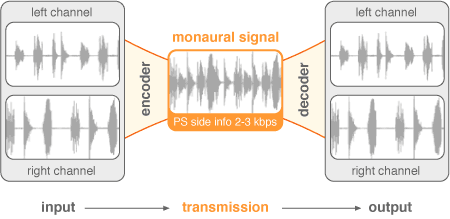
- Overview
- Features
- Specifications
- Parameters
- Performance
- Technology
- Players
- Servers
- Mobile Streaming
- Eval Streams
- Codec Comparisons
- Cost
- Technical Manual
- Podcasting
- Compare
- PDF Tech Papers
- PDF Brochure

Supported Players
Supported Servers
Opticodec-PC 1020: Codec Technology
What makes Opticodec-PC codecs sound better than other popular codecs?
Opticodec-PC Streaming Audio Encoder uses Coding Technologies AAC/aacPlus codec technology, which combines three MPEG technologies: Advanced Audio Coding (AAC), Coding Technologies Spectral Band Replication (SBR), and Parametric Stereo (PS). SBR is a unique bandwidth extension technique that enables audio codecs to deliver the same quality at half the bit rate. Parametric Stereo increases the codec efficiency a second time for low bit rate stereo signals.
SBR and PS are forward and backward compatible methods to enhance the efficiency of any audio codec. AAC was chosen as the core codec for aacPlus because of its superior performance over older generation audio codecs such as MP3 or WMA. This was the reason why Apple Computer chose AAC for their market-dominating iTunes downloadable music service. Contrary to popular belief, AAC is NOT an Apple proprietary codec.
aacPlus delivers streaming and downloadable audio files at 48 kbps for FM-quality stereo, entertainment-quality stereo at 32 kbps, and good quality for mixed content even below 16 kbps mono. This efficiency makes new applications in the Internet, mobile, and digital broadcast markets viable. Moreover, unlike certain other proprietary codecs, AAC/aacPlus does not require proprietary servers for streaming.
Members of the aacPlus Codec Family
aacPlus is the latest MPEG-4 Audio technology. aacPlus v1 combines AAC and SBR. aacPlus v2 builds on the success of aacPlus v1 and adds more value where highest compression efficiency for stereo signals is required. aacPlus v2 is a true superset of aacPlus v1, as aacPlus v1 is of AAC. With the addition of Parametric Stereo in MPEG, aacPlus v2 is the state-of-the-art low bit rate open-standards audio codec.
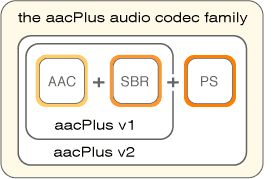
The members of the aacPlus codec family are designed for forward and backward compatibility. Besides aacPlus v2 bit streams, an aacPlus v2 encoder is also capable of creating aacPlus v1 and plain AAC bit streams.
Every decoder is able to handle bit streams of any encoder, although a given decoder may not exploit all of the stream's advanced features. An aacPlus v2 decoder can fully exploit any data inside the bit stream, be it plain AAC, aacPlus v1 (AAC+SBR), or aacPlus v2 (AAC+SBR+PS). An AAC decoder decodes the AAC portion of the bit stream, not the SBR portion. As a result, the output of the decoder is bandwidth limited, as the decoder is not able to reconstruct the high frequency range represented in the SBR data portion of the bit stream.
If the bitstream is aacPlus v2, an AAC decoder will decode it as limited-bandwidth mono and an aacPlus decoder will emit a full-bandwidth mono signal; an aacPlus v2 decoder is required to decode the parametric stereo information.
Standardization
AAC/aacPlus is an open standard and not a proprietary format unlike other lower performing codecs. It is widely standardized by many international standardization bodies as follows:
MPEG-2 AAC
MPEG ISO/IEC 13818-7:2004 Advanced Audio Coding
MPEG-4 AAC
MPEG ISO/IEC 14496-3:2001 Coding of Audio-Visual Objects - Audio
MPEG-4 aacPlus v1 = AAC LC + SBR (aka HE AAC or AAC+)
MPEG ISO/IEC 14496-3:2001/AMD-1: Bandwidth Extension
MPEG-4 aacPlus v2 = AAC LC + SBR + PS (aka Enhanced HE AAC or eAAC+)
MPEG ISO/IEC 14496-3:2001/AMD-2: Parametric Coding for High Quality Audio
aacPlus v1 is standardized by 3GPP2 (3rd Generation Partnership Project 2), ISMA (Internet Streaming Media Alliance), DVB (Digital Video Broadcasting), the DVD Forum, Digital Radio Mondiale, and many others. aacPlus v2 is specified as the high quality audio codec in 3GPP (3rd Generation Partnership Project) and all of its components are part of MPEG-4.
As an integral part of MPEG-4 Audio, aacPlus is ideal for deployment with the new H.264/AVC video codec standardized in MPEG-4 Part 10. The DVD Forum has specified aacPlus v1 as the mandatory audio codec for the DVD-Audio Compressed Audio Zone (CA-Zone). Inside DVB-H, aacPlus v2 is specified for the IP-based delivery of content to handheld devices. ARIB has specified aacPlus v1 for digital broadcasting in Japan. S-DMB/MBCo has selected aacPlus v1 as the audio format for satellite multimedia broadcasting in Korea and Japan. Flavors of MPEG-4 aacPlus or its components are also applied in national and international standards and systems such as Digital Radio Mondiale (worldwide), iBiquity's HD Radio (US), XM Satellite Radio (US), or the Enhanced Versatile Disc EVD ( China).
Independent Quality Evaluations of aacPlus
Independent tests have clearly demonstrated aacPlus v2's value. In rigorous double-blind listening tests conducted by 3GPP (3rd Generation Partnership Project), aacPlus v2 proved its superiority to its competitors even at bitrates as low as 18 kbps. aacPlus v2 provides extremely stable audio quality over a wide bit rate range, making it the first choice for all application fields in mobile music, digital broadcasting, and the Internet.
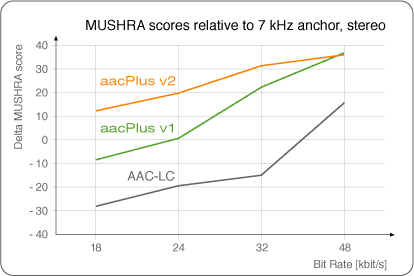
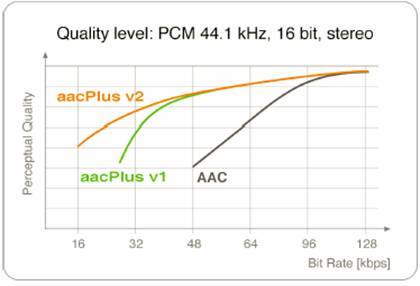
aacPlus v1 has been evaluated in multiple 3rd party tests by MPEG, the European Broadcasting Union, and Digital Radio Mondiale. aacPlus v1 outperformed all other codecs in the competition. Below is the results graph from the European Broadcasting Union testing at 48 kbps stereo.
The full "EBU subjective listening test on low bit rate audio codecs" study can be downloaded at: http://www.ebu.ch/CMSimages/en/tec_doc_t3296_tcm6-10497.pdf.

Spectral Band Replication
Low bitrate audio coding is an enabling technology for a number of applications like digital radio, Internet streaming (netcasting/webcasting) and mobile multimedia applications. The limited overall bandwidth available for these systems makes it necessary to use a low bitrate, highly efficient perceptual audio codec in order to create audio that will attract and hold listeners.
In Internet streaming applications, the connection bandwidth that can be established between the streaming server and the listener's client player application depends on the listener's connection to the Internet. In many cases today, people use analog modems or ISDN lines with a limited datarate -- lower than the rate that can produce appealing audio quality with conventional perceptual audio codecs. Moreover, even if consumers connect to the Internet through high bandwidth connections such as xDSL, or CATV, the ever-present congestion on the Internet limits the connection bitrate that can be used without audio dropouts and rebuffering. Furthermore, when netcasters pay for bandwidth by the bit, using a highly efficient perceptual codec at low bitrates can make netcasting profitable for the first time.
In mobile communications, the overall bandwidth available for all services in a certain given geographic area (a network cell) is limited, so the system operator must take measures to allow as many users as possible in that network cell to access mobile communication services in parallel. Highly efficient speech and audio codecs allow operators to use their spectrum most efficiently. Considering the impact that the advent of multimedia services has on the datarate demands in mobile communication systems, it is clear that even with CDMA2000, EDGE, and UMTS, cellular networks will find it necessary to use perceptual codecs at a relatively low datarate.
Using perceptual codecs at low bitrates, however, is not without its downside. State-of-the-art perceptual audio codecs such as AAC, achieve "CD-quality" or "transparent" audio quality at a bitrate of approximately 128 kbps (~ 12:1 compression). Below 128 kbps, the perceived audio quality of most of these codecs begins to degrade significantly. Either the codecs start to reduce the audio bandwidth and to modify the stereo image or they introduce annoying coding artifacts caused by a shortage of bits when they attempt to represent the complete audio bandwidth. Both ways of modifying the perceived sound can be considered unacceptable above a certain level. At 64 kbps for instance, AAC either would offer an audio bandwidth of only ~ 12.5 kHz or introduce a fair amount of coding artifacts. Each of these factors severely affects the listening experience.
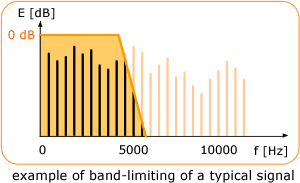
SBR (Spectral Band Replication) is one of the newest audio coding enhancement tools. It can improve the performance of low bitrate audio and speech codecs by either increasing the audio bandwidth at a given bitrate or by improving coding efficiency at a given quality level.
SBR can increase the limited audio bandwidth that a conventional perceptual codec offers at low bitrates so that it equals or exceeds analog FM audio bandwidth (15 kHz). SBR can also improve the performance of narrow-band speech codecs, offering the broadcaster speech-only channels with 12 kHz audio bandwidth used for example in multilingual broadcasting. As most speech codecs are very bandlimited, SBR is important not only for improving speech quality, but also for improving speech intelligibility and speech comprehension. SBR is mainly a post-process, although the encoder performs some pre-processing to guide the decoding process.

From a technical point of view, SBR is a method for highly efficient coding of high frequencies in audio compression algorithms. When used with SBR, the underlying coder is only responsible for transmitting the lower part of the spectrum. The higher frequencies are generated by the SBR decoder, which is mainly a post-process following the conventional waveform decoder. Instead of transmitting the spectrum, SBR reconstructs the higher frequencies in the decoder based on an analysis of the lower frequencies transmitted in the underlying coder. To ensure an accurate reconstruction, some guidance information is transmitted in the encoded bitstream at a very low data rate.
The reconstruction is efficient for harmonic as well as for noise-like components and permits proper shaping in both the time and frequency domains. As a result, SBR allows full bandwidth audio coding at very low data rates and offers significantly increased compression efficiency compared to the core coder.
SBR can enhance the efficiency of perceptual audio codecs by ~ 30% (even more in certain configurations) in the medium to low bitrate range. The exact amount of improvement that SBR can offer also depends on the underlying codec. For instance, combining SBR with AAC achieves a 64 kbps stereo stream whose quality is comparable to AAC at 128 kbps stereo. SBR can be used with mono and stereo as well as with multichannel audio.
SBR offers maximum efficiency in the bitrate range where the underlying codec itself is able to encode audio signals with an acceptable level of coding artifacts at a limited audio bandwidth.
Parametric Stereo
Parametric Stereo is the next major technology to enhance the efficiency of audio compression for low bit rate stereo signals. Parametric Stereo is fully standardized in MPEG-4 and is the new component within aacPlus v2. As of today, Parametric Stereo is optimized for the range of 16-40 kbps and provides high audio quality at bit rates as low as 24 kbps.
The Parametric Stereo encoder extracts a parametric representation of the stereo image of an audio signal. Meanwhile, a monophonic representation of the original signal is encoded via AAC+SBR. The stereo image information is represented as a small amount of high quality parametric stereo information and is transmitted along with the monaural signal in the bit stream. The decoder uses the parametric stereo information to regenerate the stereo image. This improves the compression efficiency compared to a similar bit stream without Parametric Stereo.
